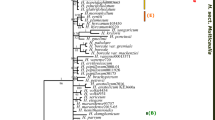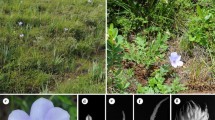Abstract
This paper presents the first molecular phylogeny of the genus Hemsleya using nuclear ITS and plastid trnH-psbA, rpl16, and trnL DNA sequences to examine the relationships among Hemsleya species. Phylogenetic relationships were elucidated using a combined analysis of all four datasets, however, the number of parsimony-informative characters was still insufficient to resolve all relationships. Parsimony and Bayesian trees were highly congruent. Twenty-three species of Hemsleya split into two major clades corresponding to two subgenera, i.e., subg. Graciliflorae and subg. Hemsleya. These results are partly in agreement with Li’s sectional classification. However, the molecular data are inconsistent with Li’s classification at the subsectional level. The molecular phylogeny revealed a striking overall correlation between the phylogenetic relationships of the species and their geographical distribution. The Kangdian ancient landmass could be the center of origin of the genus.



Similar content being viewed by others
References
Bremer B, Jansen RK, Oxelman B, Backlund M, Lantz H, Kim KJ (1999) More characters or more taxa for a robust phylogeny: case study from the coffee family (Rubiaceae). Syst Biol 48:413–435
Burland TG (2000) DNASTAR’s Lasergene sequence analysis software. Methods Mol Biol 132:71–91
Chen S-K (1995) A classificatory system and geographical distribution of the genus Gynostemma Bl (Cucurbitaceae). Acta Phytotax Sin 33:403–410
Chen Y, Chiu M-H, Gu K, Li Z-R (2003) Cucurbitacin and triterpenoid glycosides from Hemsleya gigantha. Chin Chem Lett 14:475–478
Chiu M-H, Gao J (2003) Three new cucurbitacins from Hemsleya lijiangensis. Chin Chem Lett 14:389–392
Chung SM, Decker-Walters DS, Staub JE (2003) Genetic relationships within the Cucurbitaceae as assessed by ccSSR marker and sequence analyses. Can J Bot 81:814–832
Chung SM, Staub JE, Chen JF (2006) Molecular phylogeny of Cucumis species as revealed by consensus chloroplast SSR marker length and sequence variation. Genome 49:219–229
Clarke AC, Burtenshaw MK, McLenachan PA, Erickson DL, Penny D (2006) Reconstructing the origins and dispersal of the polynesian bottle gourd (Lagenaria siceraria). Mol Biol Evol 23:893–900
Decker-Walters DS, Walters TW, Posluszny U, Kevan PG (1990) Genealogy and gene flow among annual domesticated species of Cucurbita. Can J Bot 68:782–789
Dinan L, Whiting P, Sarker SD, Kasai R, Yamasaki K (1997) Cucurbitane-type compounds from Hemsleya carnosiflora antagonize ecdysteroid action in the Drosophila melanogaster BII cell line. Cell Mol Life Sci 53:271–274
Doyle JJ, Doyle JL (1987) A rapid DNA isolation procedure for small quantities of fresh leaf tissue. Phytochem Bull 19:11–15
Farris JS, Källersjö M, Kluge AG, Bult C (1994) Testing significance of incongruence. Cladistics 10:315–319
Farris JS, Källersjö M, Kluge AG, Bult C (1995) Constructing a significance test for incongruence. Syst Biol 44:570–572
Forbes FB, Hemsley WB (1888) Index florae sinensis. J Linn Soc Lond Bot 23:490
Ganal M, Hemleben V (1986) Comparison of the ribosomal RNA genes in four closely related Cucurbitaceae. Pl Syst Evol 154:63–77
Garcia-Mas J, Monforte AJ, Arús P (2004) Phylogenetic relationships among Cucumis species based on the ribosomal internal transcribed spacer sequence and microsatellite markers. Pl Syst Evol 248:191–203
Graybeal A (1998) Is it better to add taxa or characters to a difficult phylogenetic problem? Syst Biol 47:9–17
Hall TA (1999) BioEdit: a user-friendly biological sequence alignment editor and analysis program for Windows 95/98/NT. Nucl Acids Symp Ser 41:95–98
Hano Y, Shi Y-Q, Taro Nomura, Yang P-Q, Chang W-J (1997) Two acetogenins from Hemsleya ellipsoidea. Phytochemistry 46:1447–1449
Hillis DM (1998) Taxonomic sampling, phylogenetic accuracy, and investigator bias. Syst Biol 47:3–8
Hillis DM, Bull JJ (1993) An empirical-test of bootstrapping as a method for assessing confidence in phylogenetic analysis. Syst Biol 42:182–192
Huelsenbeck JP, Ronquist F (2001) MrBayes: Bayesian inference of phylogeny. Bioinformatics 17:754–755
Jarret RL, Newman M (2000) Phylogenetic relationships among species of Citrullus and the placement of C. rehmii De Winter as determined by internal transcribed spacer (ITS) sequence heterogeneity. Genet Resour Crop Evol 47:215–222
Jeffrey C (1980a) A review of the Cucurbitaceae. Bot J Linn Soc 81:233–247
Jeffrey C (1980b) The Cucurbitaceae of Eastern Asia. Royal Botanic Gardens, Kew
Jeffrey C (1990) Systematics of the Cucurbitaceae: an overview. In: Bates DM, Robinson RW, Jeffrey C (eds) Biology and utilization of the Cucurbitaceae. Cornell University Press, Ithaca, p 3–28
Jeffrey C (2005) A new system of Cucurbitaceae. Bot Zhurn 90:332–335
Jobst J, King K, Hemleben V (1998) Molecular evolution of the internal transcribed spacers (ITS1 and ITS2) and phylogenetic relationships among species of the family Cucurbitaceae. Mol Phylogenet Evol 9:204–219
Jordan WC, Courtney MW, Neigel JE (1996) Low levels of intraspecific genetic variation at a rapidly evolving chloroplast DNA locus in North American duckweeds (Lemnaceae). Am J Bot 83:430–439
King K, Torres RA, Zentgraf U, Hemleben V (1993) Molecular evolution of the intergenic spacer in the nuclear ribosomal RNA genes of Cucurbitaceae. J Mol Evol 36:144–152
Kocyan A, Zhang L-B, Schaefer H, Renner SS (2007) A multi-locus chloroplast phylogeny for the Cucurbitaceae and its implications for character evolution and classification. Mol Phylogenet Evol 44:553–577
Kress WJ, Erickson DL (2007) A two-locus global DNA barcode for land plants: the coding rbcL gene complements the non-coding trnH-psbA spacer region. PLoS ONE 2(6): e508. doi:10.1371/journal.pone.0000508
Kress JW, Wurdack KJ, Zimmer EA, Weigt LA, Janzen DH (2005) Use of DNA barcodes to identify flowering plants. Proc Natl Acad Sci USA 102:8369–8374
Li D-Z (1993) Systematics and evolution of Hemsleya (Cucurbitaceae). Yunnan Science and Technology Press, Kunming
Lin Y-P, Chiu M-H, Li Z-R (2003) Two new compounds from Hemsleya penxianensis var. gulinensis. Chin Chem Lett 14:169–172
Lu A-M (1982) Material for the genus Hemsleya Cogn. Acta Phytotax Sin 20:87–90
Montes-Hernández S, Eguiarte LE (2002) Genetic structure and indirect estimates of gene flow in three taxa of Cucurbita (Cucurbitaceae) in western Mexico. Am J Bot 89:1156–1163
Ng TJ (1993) New opportunities in the Cucurbitaceae. In: Janick J, Simon JE (eds) New crops. Wiley, New York, pp 538–546
Nie R-L, Chen Z-L (1986) The research history and present status on the chemical components of genus Hemsleya (Cucurbitaceae). Acta Bot Yunnan 8:115–124
Nie R-L, Kasai R, Kasai R (1984) Saponins from Chinese medical plants. I. Isolation and structures of hemsloisides. Planta Med 50:322–327
Posada D, Crandall KA (1998) Modeltest: testing the model of DNA substitution. Bioinformatics 14:817–818
Qiu M-H, Chen S-K, Chen J-C, Zhou L, Li Z-R, Nie R-L (2005) Chemotaxonomy of Cucurbitaceae. Chin J Appl Environ Biol 11:673–685
Rannala B, Yang ZH (1996) Probability distribution of molecular evolutionary trees: a new method of phylogenetic inference. J Mol Evol 43:304–311
Reeves G, Chase M, Goldblatt P, Rudall P, Fay M, Cox A, Lejeune B, Chies TDE (2001) Molecular systematics of Iridaceae: evidence from four plastid DNA regions. Am J Bot 88:2074–2087
Ronquist F, Huelsenbeck JP (2003) MrBayes 3: Bayesian phylogenetic inference under mixed models. Bioinformatics 19:1572–1574
Saiki RK, Gelfand DH, Stoffel S, Scharf SJ, Higuchi R, Horn GT, Mullis KB, Erlich HA (1988) Primer-directed enzymatic amplification of DNA with a thermostable DNA-polymerase. Science 239:487–491
Sang T, Crawford DJ, Stuessy TF (1997) Chloroplast DNA phylogeny, reticulate evolution, and biogeography of Paeonia (Paeoniaceae). Am J Bot 84:1120–1136
Sanjur OJ, Piperno DR, Andres TC, Wessel-Beaver L (2002) Phylogenetic relationships among domesticated and wild species of Cucurbita (Cucurbitaceae) inferred from a mitochondrial gene: implications for crop plant evolution and areas of origin. Proc Natl Acad Sci USA 99:535–540
Shaw J, Lickey EB, Beck JT, Farmer SB, Liu W, Miller J, Siripun KC, Winder CT, Schilling EE, Small RL (2005) The tortoise and the hare II: relative utility of 21 noncoding chloroplast DNA sequences for phylogenetic analysis. Am J Bot 92:142–166
Simmons MP, Ochoterena H (2000) Gaps as characters in sequence based phylogenetic analyses. Syst Biol 49:369–381
Soltis DE, Soltis PS, Mort ME, Chase MW, Savolainen V, Hoot SB, Morton M (1998) Inferring complex phylogenies using parsimony: an empirical approach using three large DNA data sets for angiosperms. Syst Biol 47:32–42
Suzuki Y, Glazko GV, Nei M (2002) Overcredibility of molecular phylogenies obtained by Bayesian phylogenetics. Proc Natl Acad Sci USA 99:16138–16143
Swofford DL (2001) PAUP*. Phylogenetic analysis using parsimony and other methods 4.0b10. Sinauer Associates, Sunderland
Taberlet P, Gielly L, Patou IG, Bouvet J (1991) Universal primers for amplification of three non-coding regions of chloroplast DNA. Plant Mol Biol 17:1105–1109
Tate JA, Simpson BB (2003) Paraphyly of Tarasa (Malvaceae) and diverse origins of the polyploid species. Syst Bot 28:723–737
Thompson JD, Gibson TJ, Plewniak F, Jeanmougin F, Higgins DG (1997) The Clustal_X windows interface: flexible strategies for multiple sequence alignment aided by quality analysis tools. Nucleic Acids Res 25:4876–4882
Vischi M, Arzenton F, De Paoli E, Paselli S, Tomat E, Olivieri AM (2006) Identification of wild species of sunflower by a specific plastid DNA sequence. Helia 45:11–18
White TJ, Bruns T, Lee S, Taylor J (1990) Amplification and direct sequencing of fungal ribosomal RNA genes for phylogenetics. In: Innis M, Gelfand D, Sninsky J, White T (eds) PCR protocols: a guide to methods and application. Academic Press, San Diego, pp 315–322
Wiens JJ (1998) Combining data sets with different phylogenetic histories. Syst Biol 47:568–581
Wilcox TP, Zwickl DJ, Heath TA, Hillis DM (2002) Phylogenetic relationships of the dwarf boas and a comparison of Bayesian and bootstrap measures of phylogenetic support. Mol Phylogenet Evol 25:361–371
Wilson HD, Doebley J, Duvall M (1992) Chloroplast DNA diversity among wild and cultivated members of Cucurbita (Cucurbitaceae). Theor Appl Genet 84:859–865
Wortley AH, Rudall PJ, Harris DJ, Scotland RW (2005) How much data are needed to resolve a difficult phylogeny? Case study in Lamiales. Syst Biol 54:697–709
Wu C-Y, Chen Z-L (1985) Materia and floram Cucurbitacearum Sinensium–Hemsleya Cogn. Acta Phytotax Sin 23:121–143
Wu C-Y, Chen Z-L (1986) Flora reipublicae popularis sinicae, vol 73. Science Press, Beijing, pp 102–129
Wu C-Y, Wu S-G (1998) A proposal for a new floristic kingdom (realm): the E. Asiatic kingdom, its delimitation and characteristics. In: Zhang AL, Wu SG (eds) Proceedings of the first international symposium on floristic characteristics and diversity of East Asian plants. China Higher Education Press/Springer, Beijing/Berlin, pp 3–42
Wu J, Wu Y, Yang B-B (2002) Anticancer activity of Hemsleya amabilis extract. Life Sci 71:2161–2170
Yang Y-K, Chiu M-H, Gao C-W, Nie R-L, Lu Y, Zheng Q-T (2000) The novel structure of a disaccharide derivative from Hemsleya amabilis. Tetrahedron 56:7433–7435
Yoder AD, Irwi JA, Payseur BA (2001) Failure of the ILD to determine data combinability for slow loris phylogeny. Syst Biol 50:408–424
Zhang L-B, Simmons MP, Kocyan A, Renner SS (2006) Phylogeny of the Cucurbitales based on DNA sequences of nine loci from three genomes: implications for morphological and sexual system evolution. Mol Phylogenet Evol 39:305–322
Zhou T-R (1984) Physico-geography of China: palaeogeography, vol 1. Science Press, Beijing
Acknowledgments
The research was supported by the National Basic Research Program of China (973 program, grant no. 2007CB411601) and the National Natural Science Foundation of China (grant 40830209). The authors are extremely grateful to J.K. Triplett (Iowa State University), Dr. Lian-Ming Gao, Dr. Ting-Shuang Yi, and Dr. Jin-Mei Lu (KIB) for their valuable comments to help improve the manuscript.
Author information
Authors and Affiliations
Corresponding author
Rights and permissions
About this article
Cite this article
Li, HT., Yang, JB., Li, DZ. et al. A molecular phylogenetic study of Hemsleya (Cucurbitaceae) based on ITS, rpl16, trnH-psbA, and trnL DNA sequences. Plant Syst Evol 285, 23–32 (2010). https://doi.org/10.1007/s00606-009-0252-y
Received:
Accepted:
Published:
Issue Date:
DOI: https://doi.org/10.1007/s00606-009-0252-y




